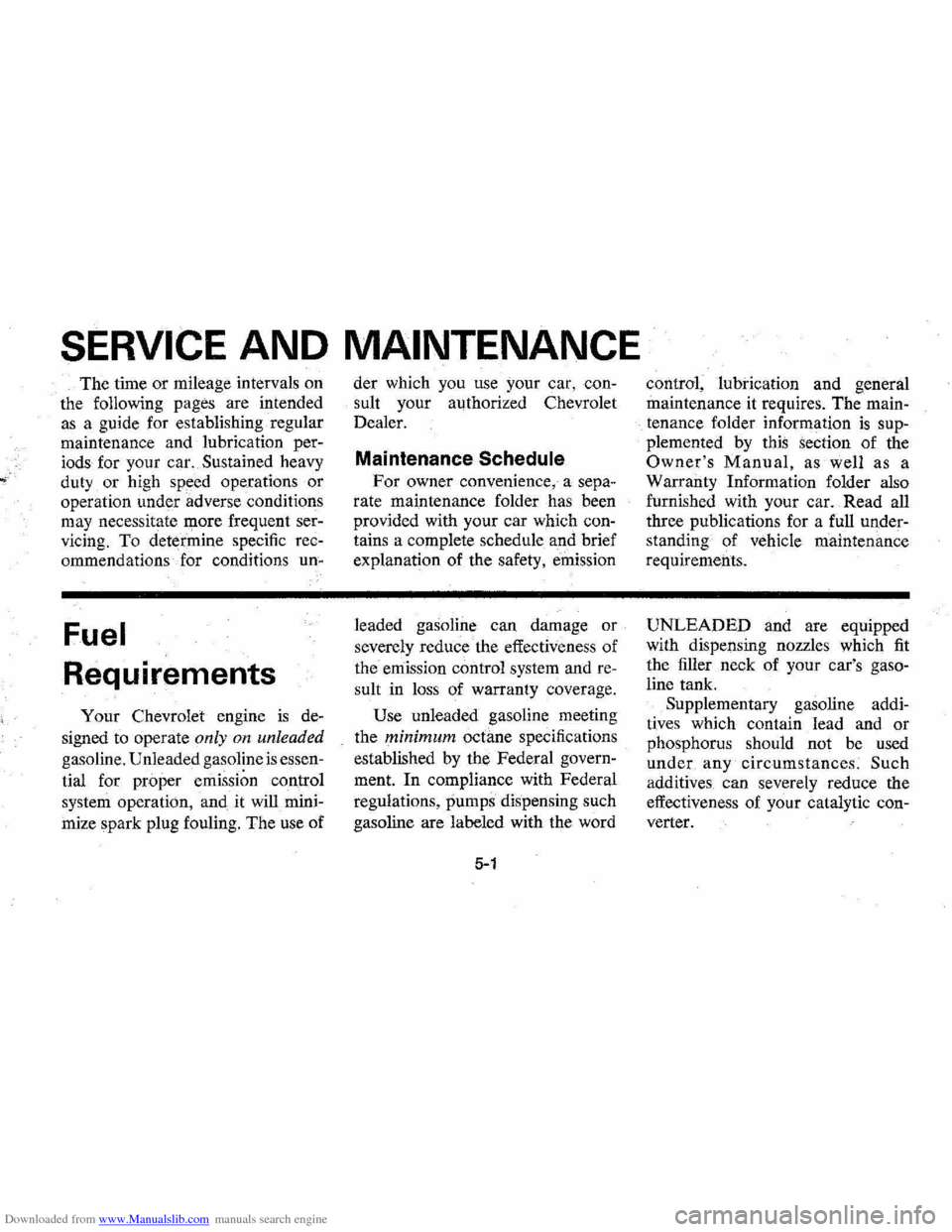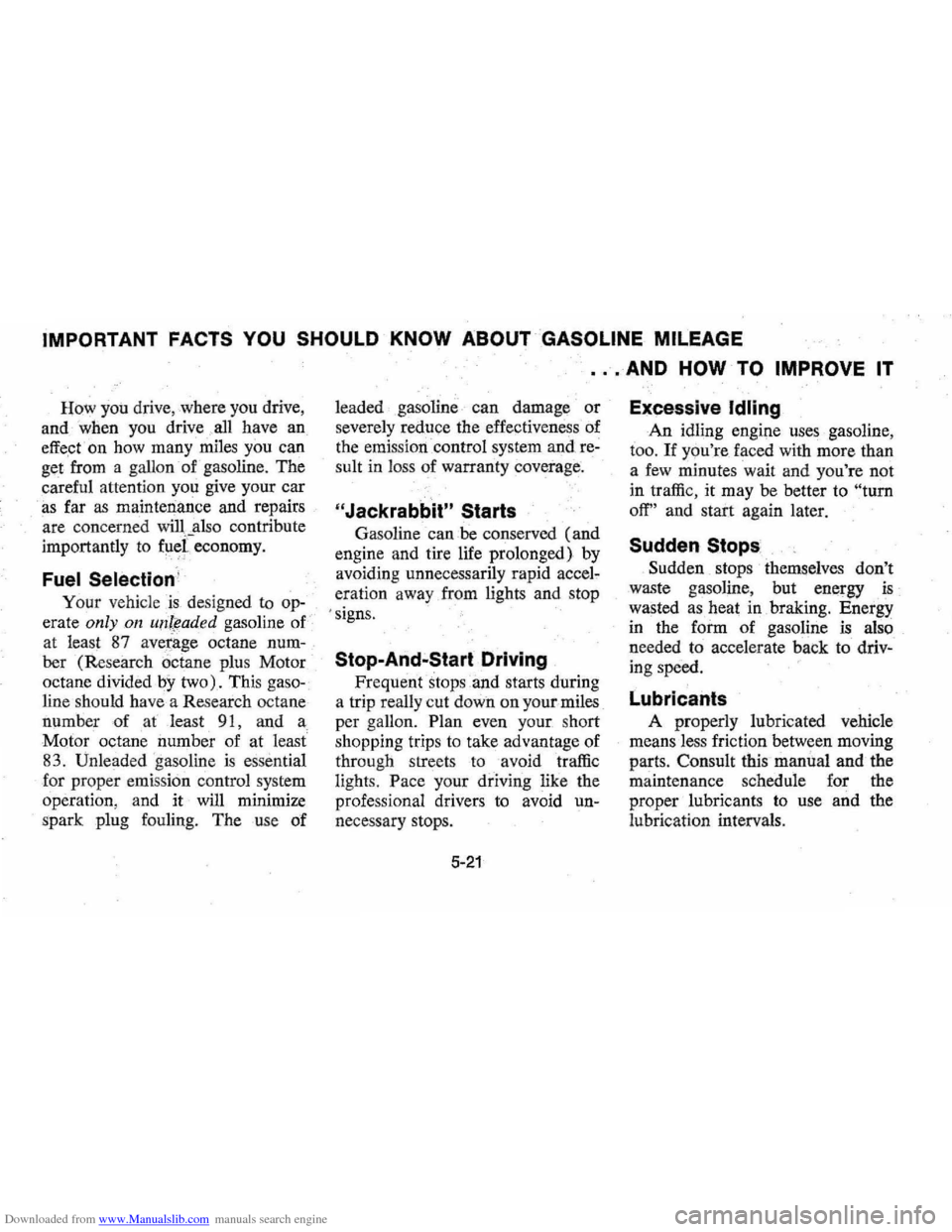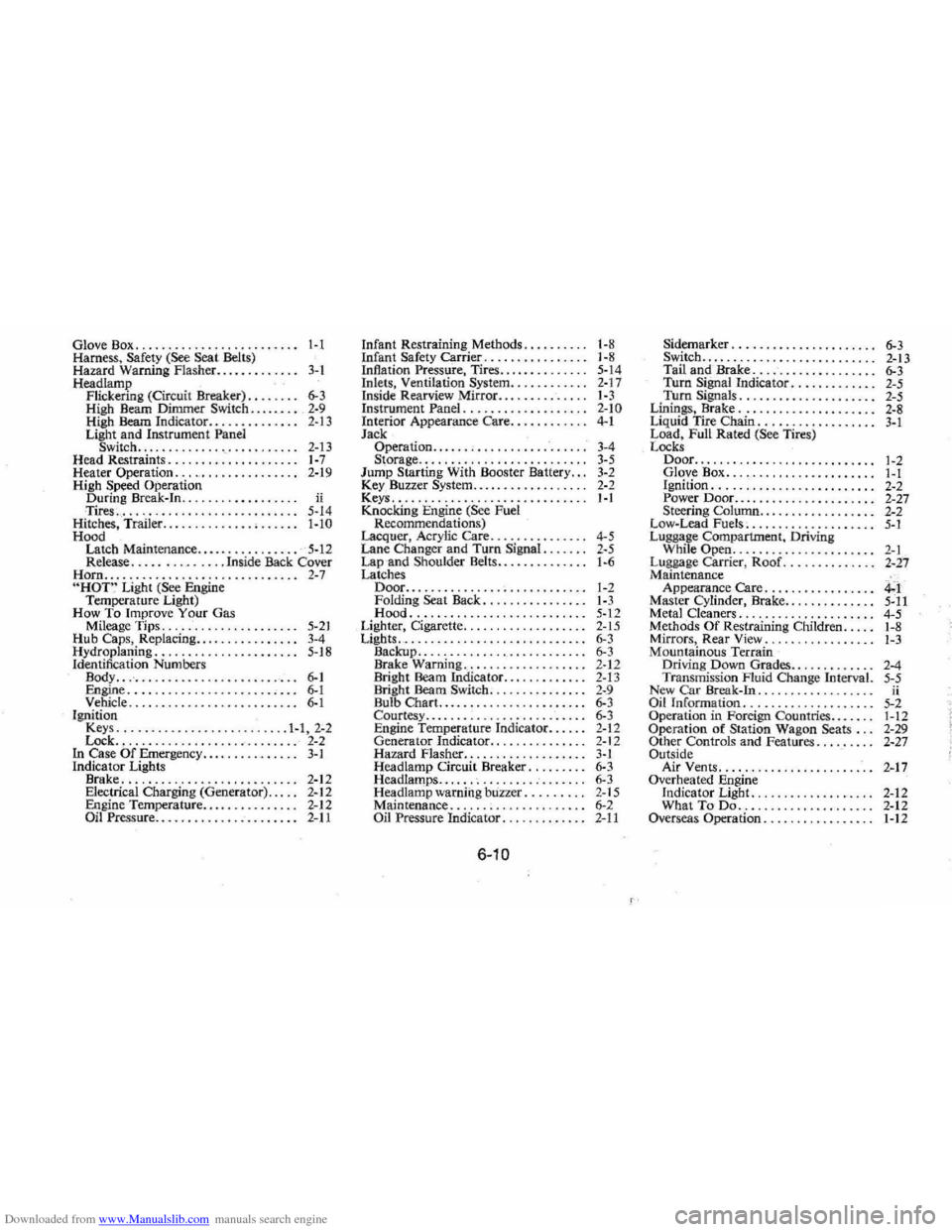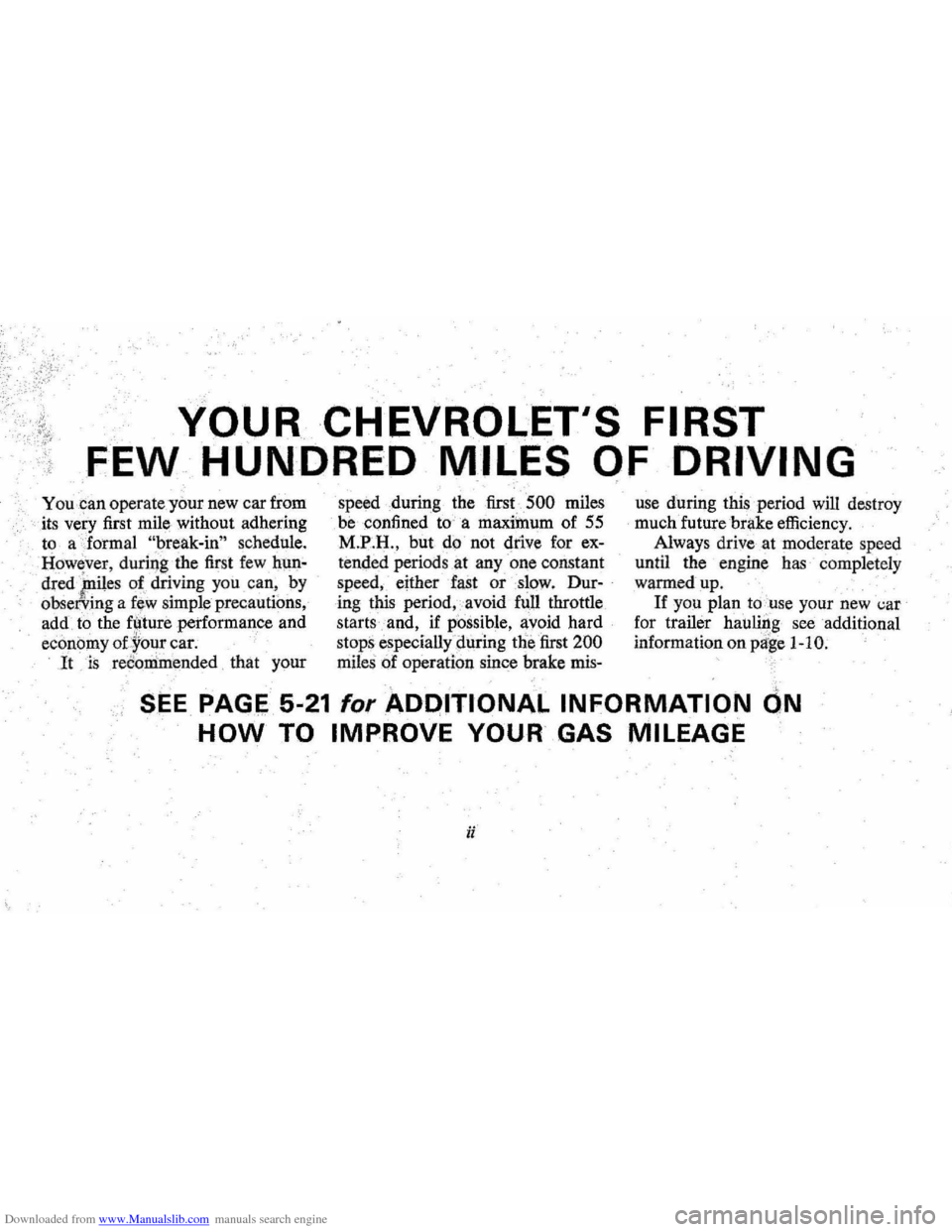gas mileage CHEVROLET MONTE CARLO 1976 2.G Owners Manual
[x] Cancel search | Manufacturer: CHEVROLET, Model Year: 1976, Model line: MONTE CARLO, Model: CHEVROLET MONTE CARLO 1976 2.GPages: 102, PDF Size: 23.79 MB
Page 62 of 102

Downloaded from www.Manualslib.com manuals search engine SERVICE AND MAINTENANCE
The time or mileage intervals on
the following pages are intended
as a guide for establishing regular
maintenance and lubrication per
iods for your car. Sustained heavy
duty or high speed operations or
operation under adverse conditions
may necessitate more frequent ser
vicing.
To determine specific rec
ommendations for conditions un-
Fuel
Requirements
Your Chevrolet engine is de
signed to operate
only on unleaded
gasoline. Unleaded gasoline is essen
tial for proper emission control
system operation, and it will mini
mize spark plug fouling. The
use of der
which you use your car, con
sult your authorized Chevrolet
Dealer.
Maintenance Schedule
For owner convenience, a sepa
rate maintenance folder has been
provided with your car which con
tains a complete schedule and brief
explanation of the safety, emission
leaded gasoline can damage or
severely reduce the effectiveness of
the emission control system and re
sult in loss of warranty coverage.
Use unleaded gasoline meeting
the
minimum octane specifications
established by the Federal govern
ment.
In compliance with Federal
regulations, pumps dispensing such
gasoline are labeled with the word
5-1
control, lubrication and general
maintenance it requires. The main
tenance folder information
is sup
plemented by this section of the
Owner's Manual, as well as a
Warranty Information folder also
furnished with your car. Read all
three publications for a full under
standing of vehicle maintenance
requiremehts.
UNLEADED and are equipped
with dispensing nozzles which
fit
the filler neck of your car's gaso
line tank.
Supplementary gasoline addi
tives which contain lead and or
phosphorus should not
be used
under any circumstances. Such
additives can severely reduce the
effectiveness of your catalytic con
verter.
Page 82 of 102

Downloaded from www.Manualslib.com manuals search engine IMPORTANT FACTS YOU SHOULD KNOW ABOUT GASOLINE MILEAGE
How you drive , where you drive ,
and when you drive
,all have an
effect
on how many miles you can
get from a gallon
of gasoline. The
careful attention you give your car
as far as maintenance and repairs
are concerned will .also contribute
importantly to
fuef economy.
Fuel Selection '
Your vehic1eis designed to op
erate only 011 unleaded gasoline of
at least 87 average octane
num
ber (Research octane plus Motor
octane divided by two). This
gaso
line should have a Research octane
number
· of at least 91, and a.
Motor octane number of at least
83. Onleadedgasoline
is essential
for proper emission co ntrol system
operation, and it will minimize
spark plug fouling. The use of
... AND HOW TO IMPROVE IT
leaded gasoline can damage or
severely reduce the effectiveness of
the emission control system and
re
sult in loss of warranty coverage.
"Jackrabbit" Starts
Gasoline can be conserved (and
engine and tire life prolonged) by
avoiding unnecessarily rapid
accel"
eration away from lights and stop
. signs,
Stop-And-Start · Driving
Frequent stops and starts during
a trip really cut down on your miles
per gallon.
Plan even your short
shopping trips to take advantage of
through streets
to avoid traffic
lights.
Pace your driving like the
professional drivers to avoid
un
necessary stops.
5-21
Excessive Idling
An idling engine uses gasoline,
too.
If you're faced with more than
a
few minutes ' wait and you're not
in traffic, it may be better to
"turn
off"
and start again later.
Sudden Stops
Sudden stops themselves don't
waste gasoline, but energy
is
wasted as heat in braking, Energy
in the form of gasoline is also
needed to accelerate back to
driv
ing speed.
Lubricants
A properly lubricated vehicle
means less friction between moving
parts. Consult this manual and the
maintenance schedule for the
proper lubricants to use and the
lubrication intervals.
Page 83 of 102

Downloaded from www.Manualslib.com manuals search engine Air Cleaner
Your Cl:
receives its power from
a
mixture of gasoline and air. The
air is taken into the system through
the air cleaner so it's important to
replace~he air cJea!1er at required
intervals. A dirty
air cleaner re
duces . engine efficiency.
Properly Tuned'Engine
Overall tuning (a check on tlin
ing , spark plugs, emission control
devices, etc;)
can improve your
car's gas mi,leage . You just
can't
expect an "out-of-tune" engine to
give you good gas mileage and
cleaner air.
Excess Weight
Fuel economy is related to the
work. the engine . must do. The
heavier the load , the more power it
take
s. Keep excess weight to a
minimum by removing any per
sonal effects or luggage from the
car or trunk when they are not
needed.
Tire Inflation
Underinfiation not only causes
needless wear of the tires, but
can
also waste gasoline. It's a good
idea to check tire pressures
regularly.
Wheel Alignment
Incorrect "toe in" or "toe out" can
have the effect,of dragging your
front tires sideways
and may cause
premature tire wear.
It takes power
to carry this extra load and that
takes gas from your tank.
Catalytic Converter
The catalytic converter is an
emi ssio n control device added to
5-22 the
exhaust system to reduce hy
drocarbon
and carbon monoxide
pollutants from the exhaust gas
stream. The converter contains
beads which are coated with a cata
lytic material containing platinum
and palladium.
Use of the catalytic converter
has the advantage
of allowing the
engine
to be re-tuned for improved
fuel economy anddriveability.
The catalytic converter requires
the use
of unleaded fuel only,
Unleaded gasoline is used to re
duce combustion chamber deposits,
corrosion
and to prevent lead con
tamination
of the catalyst that
would render it ineffective.
The use
of leaded fuel will cause the COIO- .
lytic converter to become ineffec
tive
as an emission control device.
Page 94 of 102

Downloaded from www.Manualslib.com manuals search engine Glove Box ......................... 1·1 Harness, Safety (See Seat Belts) Hazard Wa rning Flasher. . . . . . . . . . . .. 3· t H ead lamp Flickering (Circuit Breaker) ........ 6-3 High Beam Dimmer Switch ..... _. .. 2 ·9 H igh Beam Indicator.... .. .. ...... 2· 13 Ught and Instrument Panel Switch....... .. .. .. .. .. .. . ... .. 2·13 Head Restraints. . . . . . . . . . . . . . . . . . .. 1·7 Heate r Operation .... , ........•...... 2·19 High Speed Operation During Break·In... .... ....... .... ii Tires ............................ 5·14 Hit ches, Trail er ..................... 1·10 Hood latch Maintenance ..•............. 5·12 Release .............. Inside Back Cove r Horn .............................. 2·7
"HOT" Light (See Engine
Temperature Light)
H ow
To Improve Your Gas Mileage Tips ..... ' ................ 5~21 Hub Caps, Replacing.... . . . . . . . . . . .. 3A Hydroplan ing ......... , ... ....• , , .. 5·18 Identificatio n Numbers Body ........................•.... 6-1 Engine ...................... , ... 6-1 Vehicle. . . . . . . • . • . . . • . • • . . . . . . . .. (j. 1 Ignition
Key s .... , .......... , ...• ...... 1-1, 2~2 Lock.. ........ .. .. .. .. .. .. .... .. 2·2 In Case Of Emerg ency ........... , , .. 3·1 Indic ator Lights
Brake .............. , .... , ....... 2-12
Electrical Charging (Gene rator) ..... 2-12
Engine Temperature ............ , .. 2- J 2 Oil Pressure.. . . . . . . . . . . . . . . . . . ... 2-11
In fant Restraining Methods .......... 1·8 Infant Safety Carrier ..... , ... , . • . . .. J·8 Inflation Pressure, Tires. . . .. . . . . . . . .. 5·14 Inle ts, Ventilation System ......•... ,. 2·17 Inside Rearview Mirro r ........•• ,. " 1·3 Instrume m Panel. . . . . . . . . . . . . • . . . .. 2-10
I nterior Appearance Care ......•..... 41 Jack Operation ...... ;." ., .. .. .. .. .... 3-4
Storage .... , . , . , , , , . , . . . . . . . . . . .. 3-5 Jump Starting With Booster Battery. .. 3-2 Key, Buzzer System ... , ... , ... , , . . . .. 2-2 Keys .............................. 1·1 Knocking Engine (See Fuel
Recommendation s)
Lacquer, Acrylic
Care .... , ........ ,' 4-5 Lane Change r and Turn Signal. . . . . .. 2·5 Lap and Shoulder Belts .. , . . . . . . . . . .. 1·6 Latches Door ............................ 1-2 Foldi ng Seat Back .. , ....•........ 1-3
Hood ................. ,..... . ... 5·1 2 Lig hter, Cigarette. .........•.. ... ... 2-15 Lights......... ........ .... ........ 6-3 Backup.......... .. .. .......... .. 6-3 Brake Warning. _, ..... , ....... " .. 2-1 2 Bright Beam Indicator. , . , , ...•. , .. 2· 13 Bright Beam Switch ... ".......... 2-9 Bulb Chart ............ , .......... &.3 Courtesy ....... : . . . . . . . . . . . . . . . .. 6-3 Engine Temperature Indicator. . . . .. 2-12 Generator Indicator ... , . . . . . . . . . .. 2-12 Hazard Flasher ... ..... , .... , . , . .. 3·1 Head lamp Circuit Breaker. . . . . . . .. 6-3 Headlamps ..... " ... , .. , . ,'. . . . . . 6-3 Headlamp warning buzzer. . . . . . . .. 2-15 Maintenanc e ...... ~ ....... , . . . . . . 6-2
Oi l Pressur e Ind icator .. , .... , . , , .. 2-11
6-10
r'
Sidemarker ... , .. .. , , . , , , •• •... ,. (j.3 Switch ........... , .... , ..••.... ,. 2-13
T ail and Brake ......... , . • . . . . . .. &.3 Turn Signal Indicator ......... , . .. 2-5 Thm Signals .............. , . . . . .. 2-5
Lin ings, Brake, . . . . . . . . . . . . . . . . . . .. 2-8 Liquid Tire Chain .................. 3-1 Load, Full Rated (S ee Tire s) Locks DOM ... ,., ........ , .. , ...... , ... 1-2 GI~v.e Box ... , ..... , .. ,.... .... .. 1-1 IgnItion ..... , .. , . . . . . . • • . . . . . . .. 2·2
Powe r Door ...... , . . . . . . . . . . . . . .. 2-27
St ee rin g Column ................ ,. 2-2
l ow -Lead Fue ls ................ , . .. 5-1 Luggage Compartment , Driv ing
Whi le Open ........... , " . ... ,.,. 2-1 Luggage Carrie r, Roof ............. , 2-27
Maintenanc e
Appearance
Care ............ , . . .. 4.'1 Master Cylinder, Brake ... , .......... 5-11 Meta l Cleaners. , , . . . . . . . . . . . . . . . . .. 4-5
M ethods Of Restraining Children .. ". 1-8 Mirrors, Rear View ...... , ...... "., 1-3 Mountainous Terrain
Driving Down Grades.. . ...... .. .. 2-4
Transmissio n Flu id Change Interva l. 5-5 New Car Break-In ........ ,. .. .. .. .. it Oi l In for mati on .................... 5-2 Operation in Foreign Countries ...... , 1-12 Operation of Station Wagon Seats .. , 2-29 Other Controls and Features. . . • • . . .. 2-27 Outside
Air Vents ........... ,. , .......... 2-17 Ove rheated Engine
Indicator Light. ........ " ... .... ,. 2-12 What To Do ........... " .• " .. .. 2-12
O verseas Operation ..........••. , ... 1-12
Page 102 of 102

Downloaded from www.Manualslib.com manuals search engine YOUR CHEVROLET'S FIRST
FEW HUNDRED MILES OF DRIVING
You can operate your new car from
its very first mile without adhering
to a formal "break-in" schedule.
How~ver, duril )g the first few h"iUl'
dred ,Files of. driving you can, by
obserVing a feW simple precautions,
add
to the f\iture performance and
ec()nomy of:Your car. ;
, It ,is recon:inrended , that your
, ,
speed during the first 500 miles
be confined
to' a maxiinum of 55
M .P .H ., but
do not drive for ex
tended periods at anyone constant
speed, either fast or slow. Dur-'
ing this period , avoid
fUll throttle
starts and, if p()ssible, avoid hard
stops especially during
thefiTSt 200
mile s
()f operation since brake mis-
use during this, period will destroy
much future
brlike efficiency.
Always
drive at moderate speed
until the engine has completely
warmedup .
If you plan to 'use your new "ar
for trailer hauli #g see additional
information on
p~ge 1-10.
, c ~
SEE PAGI; 5·21 for ADQITIONAL INFORMATION ON
HOW TO IMPROVE YOUR GAS MILEAGE
ii